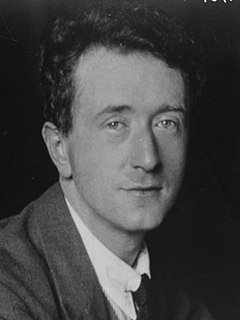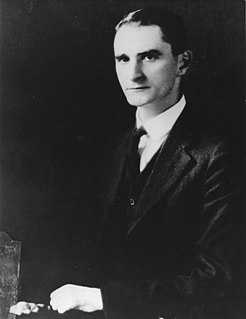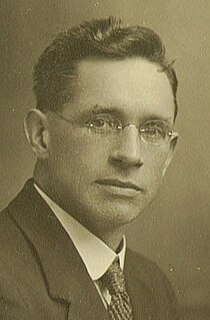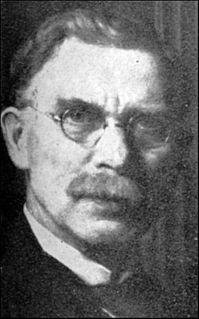The Irish Bulletin was the official gazette of the government of the Irish Republic. It was produced by the Department of Propaganda during the Irish War of Independence. and its offices were originally located at No. 6 Harcourt Street, Dublin. The paper's first editor was Desmond FitzGerald, until his arrest and replacement by Erskine Childers. The Bulletin appeared in weekly editions from 11 November 1919 to 11 July 1921.
In April 1919, Terence MacSwiney proposed the establishment of a daily paper by the Dáil for the purpose of publicity. His suggestion was not implemented until November, when 'Desmond Fitzgerald decided that some form of printed counter-propaganda was vital to republican aims and to take advantage of the success of Sinn Féin and the increasing international interest in Ireland'. [1] Fitzgerald succeeded Laurence Ginnell in the Ministry following the latter's arrest in April 1919, though he did not take up the position until July.[ citation needed ] At a Cabinet meeting held on 7 November, there was agreement that there should be "A scheme for daily news bulletin to foreign correspondents, weekly lists of atrocities; entertainment of friendly journalists approved, and £500 voted for expenses under Mr. Griffith's personal supervision." Four days later the Irish Bulletin made its début, in a run consisting of just thirty copies. [2] Five issues of the bulletin were issued each week for the next two years, despite efforts by the British authorities to suppress it. [3]
In the early days, the paper was produced mainly by Frank Gallagher [4] and Robert Brennan. Brennan, as Sinn Féin's Director of Publicity since April 1918, had played a leading role in that party's success in the 1918 General Election. [5]
Following Fitzgerald's arrest in 1921, Erskine Childers was appointed Director of Propaganda taking charge of publicity and thus becoming the paper's new editor. [6] [7] On 9 May 1921, both Childers and Gallagher were arrested and taken to Dublin Castle. Following the intervention of 'Andy' Cope, both were released that night and 'went on the run'. The hasty release of the two led to speculation between Art O'Brien and Michael Collins that there was a rift developing between the British military authorities and the civil administration. Despite the arrests, the Bulletin 'continued to appear on schedule'. [8] Alan J. Ellis, a journalist with the Cork Examiner made occasional contributions to the paper. [9] Kathleen Napoli McKenna was 'a key force behind the daily news-sheet. [10]
In the early days, the Bulletin consisted mainly of lists of raids by the security forces and the arrests of suspects. In order to stimulate interest, this was expanded in 1921 [11] at the behest of the Irish President in his direction to Childers to give more detailed accounts of events. Extracts from foreign publications, particularly sympathetic English papers, were frequently included. A regular feature was accounts from the Dáil Courts, which were reported in detail. The Bulletin was more graphic in its coverage of violence than was usual for its time. An example was its reporting on the deaths of two prominent Sinn Féin leaders, Henry and Patrick Loughnane, from Shanaglish, Gort, County Galway. The men had been handed over by the Royal Irish Constabulary to local members of the Auxiliary Division. [12]
On Dec 6th, the bodies were found in a pond. The skulls were battered in and the flesh was hanging loose on both bodies.The two men were evidently tied by the neck to a motor lorry and dragged after it until they were dead. Before the bodies were hidden in a pond an effort was made to burn them. [13]
On the night of 26–27 March 1921, the offices of the Irish Bulletin were discovered by the British authorities. [14] Captured typewriters and duplicators were used to fabricate bogus issues of the paper. These were distributed to the usual subscribers using lists found at the office. Lord Henry Cavendish-Bentinck MP on receiving some of the counterfeit papers through the post, asked in the House that those responsible 'not (to) waste their money in sending me any more of their forgeries.' [15] The initial efforts of the forgers, Captains Hugh Pollard and William Darling were of poor quality and easily identified as counterfeit. [16] [17]

The Irish Republic was a revolutionary state that declared its independence from the United Kingdom in January 1919. The Republic claimed jurisdiction over the whole island of Ireland, but by 1920 its functional control was limited to only 21 of Ireland's 32 counties, and British state forces maintained a presence across much of the north-east, as well as Cork, Dublin and other major towns. The republic was strongest in rural areas, and through its military forces was able to influence the population in urban areas that it did not directly control.
The Second Dáil was Dáil Éireann as it convened from 16 August 1921 until 8 June 1922. From 1919 to 1922, Dáil Éireann was the revolutionary parliament of the self-proclaimed Irish Republic. The Second Dáil consisted of members elected at the 1921 elections, but with only members of Sinn Féin taking their seats. On 7 January 1922, it ratified the Anglo-Irish Treaty by 64 votes to 57 which ended the War of Independence and led to the establishment of the Irish Free State on 6 December 1922.
The First Dáil was Dáil Éireann as it convened from 1919 to 1921. It was the first meeting of the unicameral parliament of the revolutionary Irish Republic. In the December 1918 election to the Parliament of the United Kingdom, the Irish republican party Sinn Féin won a landslide victory in Ireland. In line with their manifesto, its MPs refused to take their seats, and on 21 January 1919 they founded a separate parliament in Dublin called Dáil Éireann. They declared Irish independence, ratifying the Proclamation of the Irish Republic that had been issued in the 1916 Easter Rising, and adopted a provisional constitution.

The Irish War of Independence or Anglo-Irish War was a guerrilla war fought in Ireland from 1919 to 1921 between the Irish Republican Army and British forces: the British Army, along with the quasi-military Royal Irish Constabulary (RIC) and its paramilitary forces the Auxiliaries and Ulster Special Constabulary (USC). It was part of the Irish revolutionary period.

Arthur Joseph Griffith was an Irish writer, newspaper editor and politician who founded the political party Sinn Féin. He led the Irish delegation at the negotiations that produced the 1921 Anglo-Irish Treaty, and served as the president of Dáil Éireann from January 1922 until his death in August 1922.

Desmond FitzGerald was an Irish revolutionary, poet, publicist and Fine Gael politician who served as Minister for Defence from 1927 to 1932, Minister for External Affairs from 1922 to 1927, Minister for Publicity from 1921 to 1922 and Director of Publicity from 1919 to 1921. He served as a Teachta Dála (TD) from 1918 to 1938. He was a Senator for the Administrative Panel from 1938 to 1943. He served as a Member of Parliament for Dublin Pembroke from 1918 to 1922.
Events from the year 1922 in Southern Ireland, later Ireland.

The members of the First Dáil, known as Teachtaí Dála (TDs), were the 101 Members of Parliament (MPs) returned from constituencies in Ireland at the 1918 United Kingdom general election. In its first general election, Sinn Féin won 73 seats and viewed the result as a mandate for independence; in accordance with its declared policy of abstentionism, its 69 MPs refused to attend the British House of Commons in Westminster, and established a revolutionary parliament known as Dáil Éireann. The other Irish MPs — 26 unionists and six from the Irish Parliamentary Party (IPP) — sat at Westminster and for the most part ignored the invitation to attend the Dáil. Thomas Harbison, IPP MP for North East Tyrone, did acknowledge the invitation, but "stated he should decline for obvious reasons". The Dáil met for the first time on 21 January 1919 in Mansion House in Dublin. Only 27 members attended; most of the other Sinn Féin TDs were imprisoned by the British authorities, or in hiding under threat of arrest. All 101 MPs were considered TDs, and their names were called out on the roll of membership, though there was some laughter when Irish Unionist Alliance leader Edward Carson was described as as láthair ("absent"). The database of members of the Oireachtas includes for the First Dáil only those elected for Sinn Féin.
There were two elections in Ireland on 24 May 1921, as a result of the Government of Ireland Act 1920 to establish the House of Commons of Northern Ireland and the House of Commons of Southern Ireland. A resolution of Dáil Éireann on 10 May 1921 held that these elections were to be regarded as elections to Dáil Éireann and that all those returned at these elections be regarded as members of Dáil Éireann. According to this theory of Irish republicanism, these elections provided the membership of the Second Dáil. The Second Dáil lasted 388 days.

Joseph O'Doherty was an Irish teacher, barrister, revolutionary, politician, county manager, member of the First Dáil and of the Irish Free State Seanad.

John Joseph O'Kelly was an Irish republican politician, author and publisher who served as President of Sinn Féin from 1926 to 1931, Minister for Education from 1921 to 1922, Minister for Irish from 1920 to 1921 and Leas-Cheann Comhairle of Dáil Éireann from 1919 to 1921. He served as a Teachta Dála from 1918 to 1921 and 1922 to 1923.
Sinn Féin is the name of an Irish political party founded in 1905 by Arthur Griffith. It subsequently became a focus for various forms of Irish nationalism, especially Irish republicanism. After the Easter Rising in 1916, it grew in membership, with a reorganisation at its Ard Fheis in 1917. Its split in 1922 in response to the Anglo-Irish Treaty which led to the Irish Civil War and saw the origins of Fianna Fáil and Fine Gael, the two parties which have since dominated Irish politics. Another split in the remaining Sinn Féin organisation in the early years of the Troubles in 1970 led to the Sinn Féin of today, which is a republican, left-wing nationalist and secular party.
Seán O'Mahony was an Irish Sinn Féin politician and member of the First and Second Dáil.

Mary MacSwiney was an Irish politician and educationalist. In 1927 she became leader of Sinn Féin when Éamon de Valera resigned from the presidency of the party.

Conor Collins, known as Con Collins, was an Irish Sinn Féin politician.

Thomas Kelly was an Irish Sinn Féin and later Fianna Fáil politician. He was a book and picture dealer before entering politics. He was a founder member of Sinn Féin and was elected to Dublin City Council. Kelly was arrested after the 1916 Easter Rising and sent to prison in England, and after becoming seriously ill, he was released back to Dublin.
David Rice Kent was an Irish Sinn Féin politician.

The Sinn Féin Bank, formally the Sinn Féin Co-operative People's Bank, Ltd. was a co-operative bank in Ireland associated with the Sinn Féin movement, which operated from August 1908 to October 1921. The Sinn Féin Bank is sometimes confused with the National Land Bank, established as a friendly society in 1919 with Dáil backing and premises at 5 Harcourt Street.
Kathleen Napoli McKenna was an Irish republican activist, and journalist.